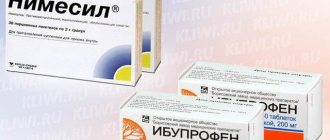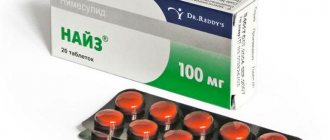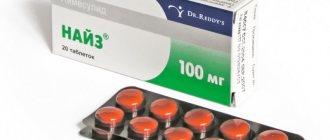Ibuprofen is rightfully considered the most effective and common remedy for treating the symptoms of colds and acute respiratory viral infections. Some patients successfully relieve fever with its help and consider it an antipyretic, while others relieve serious pain of a chronic nature, for example, in the spine. The fact is that Ibuprofen has three properties at the same time: anti-inflammatory, analgesic and antipyretic.
Ibuprofen
Indications for use
Ibuprofen belongs to the group of non-steroidal anti-inflammatory drugs (NSAIDs) - derivatives of phenylpropionic acid. In the instructions for tablets and capsules for adults, we see primarily prescriptions related to the symptomatic treatment of diseases of the joints or spine (rheumatoid arthritis, osteoarthritis, bursitis, sciatica), the fight against pain from injuries, myalgia and neuritis. In children's forms, we find the following indications: sore throat, pain with otitis media, teething, reduction of fever during ARVI or influenza, relief of symptoms of fever during childhood infections and post-vaccination reactions.
Of course, the indications are not limited to those mentioned above. We list here the most common types of pathologies where Ibuprofen does an excellent job eliminating inflammation and pain:
- Pathologies of the musculoskeletal system, pain relief: ankylosing spondylitis, radiculitis, spinal osteochondrosis, exacerbation of gout, polyarthrosis, psoriatic arthritis, tendinitis, inflammation of soft tissues in injuries, back pain, joint pain, trauma, sprains, dislocations, myalgia of various types .
- Diseases of the peripheral nervous system: neuralgia and neuritis.
- Gynecology: primary dysmenorrhea, secondary dysmenorrhea, pain during painful menstruation, with adnexitis.
- Relief of various types of pain: toothache, headache, migraine, sore throat, ear pain with otitis media, muscle pain.
- Use as an antipyretic for fever, flu, ARVI and colds. Increased temperature in infectious and inflammatory diseases.
- Relief after vaccination, including against coronavirus.
The use of ibuprofen in gynecological practice
Probably, almost every woman at least once in her life has encountered such a condition as painful menstruation. For some, pain during menstruation is so severe that it can render a woman completely incapacitated. In other words, pain is not uncommon in a woman’s life. At the same time, in gynecological practice we often have to perform all sorts of invasive interventions, accompanied by pain, sometimes quite severe, for which it is usually not customary to use general anesthesia. In this situation, you have to resort to non-narcotic analgesics, the effectiveness of which can vary quite a lot. In this article we want to touch upon the issue of pain in gynecological practice and offer treatment options for this condition.
Dysmenorrhea or painful menstruation
are one of the most common reasons why women miss work or school. In many state-owned enterprises, there is still such a thing as “women’s day,” which allows a woman to experience “critical days” outside of the workplace once a month.
Dysmenorrhea is divided into primary and secondary. Under primary dysmenorrhea
understand painful menstruation in the absence of pathological changes in the genital organs.
With secondary dysmenorrhea,
painful menstruation is caused by the presence of gynecological diseases. Most often these include endometriosis, inflammatory diseases of the genital organs, uterine fibroids and others. According to various authors, the incidence of dysmenorrhea depending on age ranges from 60 to 92%. It is obvious that primary dysmenorrhea occurs mainly in adolescents, while secondary dysmenorrhea is typical for older age groups.
Primary dysmenorrhea usually develops 6–12 months after menarche, when the first ovulatory cycles appear. Symptoms of dysmenorrhea usually occur with the onset of menstruation, rarely the day before, and are characterized by cramping, aching, jerking, bursting pain that can radiate to the rectum, appendages and bladder. In addition, nausea, vomiting, headache, irritability, bloating and other autonomic phenomena may occur.
Among adolescents, the peak incidence of dysmenorrhea occurs at 17–18 years of age, that is, at the time of the final formation of menstrual function and the formation of the ovulatory menstrual cycle. This pattern, in particular, indicates the significant role of ovulation in the pathogenesis of primary dysmenorrhea.
Although there is still no clear idea about the etiology of primary dysmenorrhea, most researchers agree that the leading role in the development of this disease is played by an imbalance of prostaglandins in the uterus
.
As early as 1978, it was shown that prostaglandin F2a (PGF2a) and prostaglandin E2 (PGE2) accumulate in the endometrium during menstruation and cause symptoms of dysmenorrhea [1]. Prostaglandin F2a and PGE2 are synthesized from arachidonic acid through the so-called cyclooxygenase pathway. The activity of this enzyme pathway in the endometrium is regulated by sex hormones, more precisely, by sequential stimulation of the endometrium, first with estrogens and then with progesterone. By the time of menstruation, a large concentration of prostaglandins accumulates in the endometrium, which are released due to lysis of endometrial cells. Prostaglandins released from the cells act on the myometrium, which leads to alternating constriction and relaxation of smooth muscle cells. Uterine contractions caused by prostaglandins can last several minutes, and the pressure developed in the uterus can reach 60 mm Hg. Prolonged contractions of the uterus lead to the development of ischemia and, as a consequence, to the accumulation of anaerobic metabolic products, which, in turn, stimulate C-type pain neurons. In other words, primary dysmenorrhea can be called “uterine angina.”
The role of prostaglandins in the development of primary dysmenorrhea is confirmed by a study that found that the concentration of prostaglandins in the endometrium correlates with the severity of symptoms, that is, the higher the concentration of PGF2a and PGE2 in the endometrium, the more severe the dysmenorrhea [2].
Many factors can modulate the effect of prostaglandins on the uterus. For example, vigorous exercise may increase uterine tone, possibly by reducing uterine blood flow. Many female athletes note that intense training during menstruation significantly increases the symptoms of dysmenorrhea. In addition to affecting the uterus, PGF2a and PGE2 can cause bronchoconstriction, diarrhea and hypertension, so, in particular, diarrhea most often accompanies primary dysmenorrhea.
For high production of prostaglandins in the endometrium, sequential exposure to estrogens and then progesterone
. It is obvious that women with an anovulatory menstrual cycle extremely rarely suffer from primary dysmenorrhea due to their lack of sufficient progesterone secretion. In this regard, the presence of ovulation is one of the factors causing the symptoms of dysmenorrhea.
The most common drugs for treatment
primary dysmenorrhea are
oral contraceptives and non-steroidal anti-inflammatory drugs
(NSAIDs). The prescription of oral contraceptives is mainly aimed at stopping ovulation, since, as noted above, it is the ovulatory menstrual cycle that provides cyclic stimulation of the endometrium, which contributes to the accumulation of prostaglandins responsible for the development of symptoms of dysmenorrhea. This method of treatment is quite effective, but when choosing it it is necessary to take into account a number of factors. Firstly, the majority of patients with primary dysmenorrhea are adolescents who are not sexually active, for whom the problem of contraception accompanying the treatment is not so relevant, and the belief in the inevitable gain of excess weight “from hormones” is extremely strong. Secondly, it is not possible to prescribe oral contraceptives in all cases, since they have a number of contraindications. Thirdly, the therapeutic effect from the prescription of oral contraceptives develops only after 2–3 months from the start of their use, which makes their use irrational in cases of particularly severe disease. Thus, the use of oral contraceptives for the treatment of primary dysmenorrhea is optimal in cases where the patient, in addition to treatment, requires reliable contraception, as well as in cases of mild to moderate symptoms.
Another equally effective approach to the treatment of primary dysmenorrhea is the prescription of NSAIDs, in particular the drug ibuprofen
(Nurofen)
, which is most widely used in world clinical practice.
Nurofen (ibuprofen) is a derivative of phenylpropionic acid. Nurofen inhibits the synthesis of prostaglandins by inhibiting the activity of cyclooxygenase. After oral administration, ibuprofen is rapidly absorbed from the gastrointestinal tract, its maximum concentration in the blood plasma is determined after 1–2 hours. Ibuprofen is metabolized in the liver, excreted by the kidneys unchanged and in the form of conjugates, the half-life is 2 hours. Unlike other NSAIDs, side effects are extremely rarely observed when using Nurofen, which are mainly characterized by mild digestive disorders. For the treatment of primary dysmenorrhea, Nurofen is prescribed at an initial dose of 400 mg, then the drug is prescribed at a dose of 200–400 mg every 4 hours, the maximum daily dose of Nurofen is 1200 mg. Obviously, the dose of Nurofen should be selected depending on the severity of the symptoms of the disease.
If the analgesic effect of Nurofen is not enough, it is possible to use the combination drug Nurofen Plus
. This drug combines ibuprofen with codeine, an analgesic that acts on opiate receptors in the central nervous system. This combination gives a more pronounced analgesic effect.
In general, the use of NSAIDs for the treatment of primary dysmenorrhea has a number of advantages over the use of oral contraceptives. Unlike oral contraceptives, which should be taken for several months, NSAIDs are prescribed only for 2-3 days a month, which, on the one hand, is more convenient, and on the other, more cost-effective. In addition, NSAIDs not only effectively neutralize the negative effects of prostaglandins on the uterus, but also eliminate other symptoms of dysmenorrhea, such as nausea, vomiting and diarrhea.
Objectively speaking, it was the high effectiveness of NSAIDs in treating not only the main but also accompanying symptoms of primary dysmenorrhea that confirmed the hypothesis about the role of prostaglandins in the pathogenesis of this disease, and therefore it is obvious that NSAIDs are first-line drugs in the treatment of primary dysmenorrhea
.
Although primary dysmenorrhea is one of the most common gynecological diseases accompanied by pain, a number of other gynecological pathologies often require the use of effective analgesics.
Secondary dysmenorrhea
, as noted above, is due to the presence of organic disorders of the genitals (Table 1).
There are a number of factors that help distinguish secondary dysmenorrhea from primary.
1. Symptoms of dysmenorrhea appear during the first or second menstrual cycle after menarche (congenital obstructive malformations).
2. Symptoms of dysmenorrhea first appear after the age of 25 years.
3. Presence of gynecological diseases: infertility (endometriosis, inflammatory diseases of the pelvic organs or other causes of adhesions are assumed), heavy menstruation or intermenstrual bleeding (adenomyosis, uterine fibroids, polyps are assumed), dyspareunia.
4. Lack of effect or its insignificant severity from therapy with NSAIDs and/or oral contraceptives.
The most common cause of secondary dysmenorrhea is endometriosis
. Characteristic symptoms of endometriosis are: the appearance of progressively increasing pain that occurs immediately before or during menstruation; dyspareunia, painful bowel movements, premenstrual spotting and polymenorrhea; pain over the pubis, dysuria and hematuria; infertility. A number of patients may not identify pain as an acquired phenomenon, but simply note that they have painful menstruation, although most indicate increased pain during menstruation. The pain is most often bilateral and ranges in intensity from mild to extremely severe; pain is often associated with a feeling of pressure in the rectum and can radiate to the back and leg. Constant “unpleasant sensations” throughout the menstrual cycle, intensifying before menstruation or during coitus, may be the only complaint presented by a patient with endometriosis. The cause of the pain has not been fully established; it is assumed that it may be associated with the phenomenon of “miniature menstruation” of endometriotic explants, which leads to irritation of the nerve endings. The disappearance of pain during the induction of amenorrhea in patients with endometriosis, that is, the elimination of cyclic hormonal effects on endometrioid explants, in fact, proves the mechanism of pain syndrome.
However, pain is not always associated with endometriosis, even in cases where the disease is severe. For example, bilateral large endometrioid ovarian cysts are most often asymptomatic unless they rupture, while severe discomfort may be a consequence of a minimal number of active endometrioid heterotopias.
Despite the fact that there is a completely definite pathogenetic therapy for endometriosis, including the use of GnRH agonists and 19-norsteroid derivatives, quite often in the first stages of treatment, and sometimes over longer periods, it is necessary to add analgesics to the main drugs. This is due to the fact that the basic drugs do not have their maximum effect immediately, and in some cases the basic drugs are not able to completely eliminate the pain syndrome. Thus, the drug Nurofen or Nurofen Plus also finds its place in the treatment of endometriosis.
Everyday gynecological practice
cannot do without procedures such as the introduction and removal of intrauterine devices, treatment of cervical pathology, endometrial biopsy, hysterosalpingography, etc. Of course, in most cases, these interventions do not require the use of pain medications at all. The era of abortions performed without any anesthesia has not yet been forgotten. One could simply shout at the patient - “be patient, they didn’t tolerate this during the war” - and that would be the end of it, but in modern conditions this is completely unacceptable. Moreover, all of the above procedures can be quite well anesthetized and thereby achieve good emotional tolerance of these interventions. For this purpose, it is also possible to use Nurofen Plus, preferably 20–30 minutes before the procedure and subsequently after its completion. Taking this drug once or twice, depending on the severity of the pain syndrome, will provide the patient with pleasant memories of a caring doctor.
We would like to touch upon one more, fairly common pain syndrome within the framework of this story. We are talking about the so-called pelvic ganglioneuritis
. This is a variant of radiculitis, in which the nerve trunks exiting in the pelvic area are pinched. Patients with this disease most often complain of recurrent pain in the iliac regions. As a rule, the examination fails to reveal any signs of an inflammatory process in the uterine appendages or any other pathological changes. The pain syndrome in such patients is quite well controlled by taking analgesics from the NSAID group, in particular Nurofen.
Since 2001, in our clinic for the treatment of patients with uterine fibroids
We began to use the method of uterine artery embolization. After the procedure, patients usually experience pain of varying severity. The duration of this syndrome also varies, but on average it is 8 days. We used various pain relief regimens in this category of patients and settled on a regimen that included the use of Nurofen and Nurofen Plus. In particular, we were able to note a more pronounced analgesic effect of this drug, a rapid onset of effect and good tolerability.
Thus, Nurofen and Nurofen Plus are widely used in gynecological practice, effectively relieving women of pain.
Literature:
1. Ylikorkala O, Dawood MY New concept in dysmenorrhea. Am J Obstet Gynecol 1978; 130:833
2. Chan WY, Dawood MY, Fuchs F. Relief of dysmenorrhea with the prostaglandin synthetase inhibitor ibuprofen: effect of prostaglandin levels in menstrual fluid. Am J Obstet Gynecol 1979; 135:102.
What forms does Ibuprofen come in?
In pharmacies you can find four dosage forms of the drug:
- If there are no contraindications related to the gastrointestinal tract, then people usually choose tablets or capsules.
- In cases where there is a stomach disease in the acute stage or the patient for some reason cannot swallow a tablet, suppositories are prescribed.
- Syrups are prescribed to infants. Most pediatricians prefer to reduce fever using Ibuprofen rather than Paracetamol, since the former acts faster and longer, and also has a lower safety profile due to the absence of toxic metabolites.
- For pain in the joints, muscles, back, and injuries, the ointment is ideal.
Ibuprofen CAPS - analgesic and antipyretic agent
Undesirable effects can be minimized by using a low effective dose for the short time needed to control symptoms.
The drug is prescribed with caution to elderly patients, as they are more likely to experience adverse side reactions to NSAIDs, mainly gastrointestinal bleeding and perforation, which can lead to a sharp deterioration of the condition.
Respiratory system:
Caution should be exercised when using the drug in patients with bronchial asthma and other obstructive pulmonary diseases due to the risk of bronchospasm.
Other NSAIDs:
The simultaneous use of Ibuprofen CAPS and other NSAIDs, including selective cyclooxygenase-2 inhibitors, should be avoided.
Systemic lupus erythematosus, as well as mixed connective tissue diseases, increase the risk of aseptic meningitis.
Kidneys:
The drug is used with caution in case of renal failure, because Renal function may deteriorate.
Liver:
The drug should be used with caution in cases of liver dysfunction.
Cardiovascular and cerebrovascular effects:
The drug is prescribed with caution to patients with heart failure, arterial hypertension, and bleeding disorders.
Clinical trials and epidemiological data suggest that ibuprofen, especially at high doses (2400 mg daily) and long-term treatment, may be associated with a small increased risk of arterial thrombotic complications (eg, myocardial infarction or stroke). In general, epidemiological studies do not suggest that low doses of ibuprofen (eg, ≤1200 mg daily) are associated with an increased risk of myocardial infarction.
Female fertility disorders:
There is limited evidence that drugs that inhibit cyclooxygenase/prostaglandin synthesis may impair female fertility by affecting ovulation. This phenomenon is reversible when the drug is discontinued.
Gastrointestinal tract:
Patients with diseases of the gastrointestinal tract (ulcerative colitis, Crohn's disease) should be prescribed NSAIDs with caution due to a possible exacerbation of these diseases.
Patients with a history of gastrointestinal toxicity, especially the elderly, should report any unusual abdominal symptom (especially gastrointestinal bleeding), especially if the symptom is observed during the initial phase of taking the drug.
If patients develop gastrointestinal bleeding while taking the drug, the drug should be stopped immediately.
Caution should be exercised in patients receiving concomitant medications that may increase the risk of ulceration or bleeding, such as oral corticosteroids, anticoagulants such as warfarin, selective serotonin reuptake inhibitors, or antiplatelet agents such as aspirin.
Dermatological:
Serious skin reactions, some fatal, including exfoliative dermatitis, Stevens-Johnson syndrome, and toxic epidermal necrolysis, have been reported very rarely in association with the use of NSAIDs. Ibuprofen CAPS should be discontinued at the first appearance of skin rash, mucosal lesions, or any other signs of hypersensitivity.
Instructions for taking Ibuprofen for adults and children.
- A single dosage for an adult is 200 mg; in case of severe pain, you can take 400 mg, the dosage frequency is 3-4 times a day, but not more than 1200 mg per day.
- A single dose for a child over 6 years old is 200 mg, can be taken 3-4 times a day. The maximum dosage for children per day differs by age as follows: for children 12-17 years old - 1000 mg; for children aged 6 to 12 years - 800 mg.
Ibuprofen Welfarm for adults
How many days can you take Ibuprofen?
The drug is taken for 2-3 days; if the patient’s condition does not improve or becomes worse, it is necessary to stop taking it and consult a doctor.
ASA - acetylsalicylic acid
Gastrointestinal tract - gastrointestinal tract
IHD - coronary heart disease
LS - medicines
NSAIDs - non-steroidal anti-inflammatory drugs
COX - cyclooxygenase
PG - prostaglandin
TxA2 - thromboxane
It is difficult to imagine modern clinical practice without the use of various nonsteroidal anti-inflammatory drugs (NSAIDs). In Ancient Greece, more than 3.5 thousand years ago, Hippocrates used willow bark extract as an antipyretic and analgesic. Much later, in the 17th century, a substance was isolated from it, which was called salicylic acid (from the Latin salix - willow). At the end of the 19th century, the production of salicylic acid and acetylsalicylic acid (ASA) began in Germany. Currently, more than 20 different representatives of this group are known in clinical practice, differing in chemical structure, features of the mechanism of action, indications for use and tolerability.
Mechanism of action of NSAIDs.
NSAIDs inhibit the synthesis of prostaglandins (PGs), which are important physiological and pathological mediators.
PGs are involved in processes such as pain, inflammation, tumorigenesis, osteoporosis, regulation of body temperature (hyperthermia) and kidney function, etc. From arachidonic acid, with the participation of the enzyme cyclooxygenase (COX), PGH2 is formed, which is the precursor of PGs such as thromboxane (TxA2), prostacyclin, or PGI2, D2, E2 and F2 (see figure).
Figure 1. Mechanism of action of NSAIDs [2, 3]. Two main isoforms of COX are known: COX-1 and COX-2. The issue of isolating the third isoform, COX-3, as a variant of COX-1 under experimental conditions, remains unresolved [1]. The first isoform (COX-1) is synthesized constantly and works according to a universal mechanism, i.e. regardless of in which organ or tissue the synthesis occurs. The synthesis of the second isoform (COX-2) is stimulated by various inflammatory factors (lipopolysaccharides, interleukins, tumor necrosis factor α) in various cells of the human body, such as endothelium, osteoclasts, synoviocytes, monocytes and macrophages [2].
The main pharmacodynamic properties of NSAIDs - anti-inflammatory, antipyretic and analgesic effects - are achieved through inhibition of COX-1 and COX-2. It is the inhibition of COX-1 and COX-2 that causes the main adverse reactions associated with the use of NSAIDs. Prostaglandins PGE2 and PGI2, which are synthesized with the participation of COX-1 in the gastrointestinal tract (GIT), are cytoprotectors of the mucous membrane by reducing the secretion of hydrochloric acid by parietal cells of the stomach, improving blood flow and stimulating mucus production. In addition, with the participation of COX-1, TxA2 is synthesized in platelets, which have vasoconstrictive and proaggregant properties. NSAIDs, by blocking the synthesis of COX-1, can lead to damage to the mucous membrane of the stomach and intestines and disruption of platelet aggregation. Thus, NSAIDs increase the risk of developing severe gastrointestinal diseases such as inflammation, bleeding and penetration of the stomach or intestines. The risk of developing such complications is higher in older people and does not depend on the duration of drug use [4].
The classification of NSAIDs is presented in table. 1.
Among representatives of NSAIDs, there are differences in the chemical structure, features of action and the degree of inhibition of COX-1 and COX-2.
The selectivity of NSAIDs for COX isoforms is usually assessed by the ratio of the degree of inhibition of COX-1 to COX-2 (selectivity coefficient). Selective COX-2 inhibitors are those NSAIDs that have this coefficient of more than 5, highly selective inhibitors - if this coefficient is more than 50 (see Table 1)
. NSAIDs with high selectivity for COX-2 are called coxibs (from the English - cyclo-oxygenase, abbreviated version of COX).
Clinical pharmacology of ibuprofen.
One of the NSAIDs widely used in clinical practice is ibuprofen, which was synthesized by S. Adams and D. Nicholson in Great Britain in 1962. In the Russian Federation it is registered under the trade name Nurofen (original drug). It has pronounced anti-inflammatory, analgesic and antipyretic effects, which, combined with good tolerability, predictability of side effects and low risk of complications, has led to its widespread use in clinical practice.
According to the chemical structure, ibuprofen is a derivative of propionic acid; according to the mechanism of action, it is a non-selective inhibitor of COX-1 and COX-2, lipoxygenase involved in the synthesis of pro-inflammatory leukotrienes [6].
Ibuprofen is a racemic mixture of two optical left- and right-handed isomers, the S (+) and R (–) enantiomers. The clinical effectiveness of ibuprofen is mainly due to the action of the S (+) form, but the presence of the R (–) isomer explains some of the anti-inflammatory properties of ibuprofen [7].
Variety of dosage forms of ibuprofen.
Modern possibilities for the use of ibuprofen are associated with advances in the field of pathophysiology of diseases and the development of new dosage forms of this drug. Currently, ibuprofen is presented in a variety of dosage forms on the drug market.
Not only oral administration of ibuprofen is possible, but also its topical use in the form of a gel, rectal (in the form of suppositories) and parenteral (in the form of solutions for intravenous administration) (Table 2).
Modern technologies have made it possible to develop new dosage forms - capsules containing ibuprofen solution (Nurofen Ultracap) and ibuprofen derivatives - sodium dihydrate and lysinate. The advantages of the lysine salt of ibuprofen are the speed of dissolution of this compound, increased bioavailability and the speed of onset of maximum concentration in the blood plasma (Nurofen Express) [8-10].
In clinical practice, new dosage forms with modified release are also presented, i.e. with a mechanism and nature of release of the drug substance changed in relation to the usual form. Forms of ibuprofen are known as immediate release (IR) and sustained release (SR).
Pharmacokinetics of ibuprofen.
The main pharmacokinetic parameters of ibuprofen, in particular the concentration of enantiomers in plasma or the area under the pharmacokinetic curve, depend on the dosage form and dose of ibuprofen
(see Table 2)
.
When taken orally, ibuprofen is rapidly absorbed from the upper small intestine. The bioavailability of ibuprofen as a weak acid when taken orally averages 80%. Eating generally reduces the rate of absorption of ibuprofen, but certain foods and drinks (eg, Coca-Cola) have been shown to increase the rate of absorption. The time to reach the maximum concentration of ibuprofen isomers in plasma or serum averages 1-2 hours and depends on the dosage form of ibuprofen (see Table 2)
. Based on the rate of absorption, dosage forms of ibuprofen can be distributed in ascending order: ibuprofen tablets → ibuprofen suspension → ibuprofen solution. Rapid absorption of ibuprofen from liquid forms (suspension, solution) provides a faster analgesic and antipyretic effect.
After oral administration of 40-60% of the R (-) form, ibuprofen is metabolized in the intestines and liver into the S (+) form. Further biotransformation of ibuprofen takes place in 2 phases. I - phase of oxidative reactions is associated with a system of microsomal enzymes of cytochrome P-450 (2C9, 2C8 and 2C19), which ensure the formation of inactive carboxyl and phenolic compounds. Differences in genotypes of the P-450 2C9 system lead to differences in the metabolism of ibuprofen, an increase in the area under the pharmacokinetic curve and changes in hepatic clearance [7]. Phase II of ibuprofen metabolism includes the formation of inactive glucuronic and taurine compounds, which are subsequently excreted primarily through the kidneys. Impaired liver function due to liver cirrhosis leads to a slower inversion of the R (–) form of ibuprofen to the S form (+), as well as an increase in half-life to 3.4 hours. Impaired renal function also reduces the rate of elimination of ibuprofen metabolites.
Ibuprofen has a high degree of binding to plasma albumin (90-99%). In adults, ibuprofen, when taken orally and intravenously, has a short half-life of about 2 hours. Ibuprofen penetrates well into the synovial fluid of inflamed joints, which provides analgesic and anti-inflammatory effects. The antipyretic effect of ibuprofen is due to inhibition of PGE2 synthesis in the central nervous system. Ibuprofen is a lipophilic substance, but only its free (not bound to albumin) fraction penetrates the blood-brain barrier.
With topical application of ibuprofen, there is a slight decrease in the systemic bioavailability of the drug to 14-30% of that when taken orally [12], while after topical application, higher concentrations are observed in subcutaneous and soft tissues, including muscle [13]. A number of studies in patients of different categories have shown that the effectiveness of topical application of ibuprofen (5% gel) and ibuprofen (1200 mg/day) taken orally both for acute traumatic injuries of soft tissues and for chronic pain syndrome is the same, and the tolerability of topical forms is better [12, 14, 15].
The pharmacokinetic curve indicators for rectal use are comparable to the pharmacokinetic data for oral administration of the drug. Absorption during rectal administration of ibuprofen is characterized by a high degree of bioavailability and rapid onset of maximum plasma concentration. In addition, the peculiarities of the blood supply to the rectal area lead to the fact that only part of the drug is metabolized in the liver, which leads to an increase in the half-life.
Pharmacokinetics indicators do not differ significantly between men and women, and in different age groups. Pharmacokinetic parameters in children over 2 years of age and adolescents do not differ from those in adults. The only exceptions are children under 2 years of age, whose metabolism of ibuprofen is significantly lower than that of adults, which requires the correct dosage regimen of the drug depending on the child’s body weight. With increasing age, there is a slight increase in half-life, which reflects age-related changes in metabolism and clearance, however, in older people, the elimination of ibuprofen does not undergo significant changes.
Safety of ibuprofen.
The development of selective COX-2 inhibitors was aimed at overcoming the limitations of the use of NSAIDs due to the risk of developing adverse gastrointestinal reactions. However, during the introduction of coxibs into clinical practice, another safety problem arose with long-term use - an increased risk of developing cardiovascular thrombotic complications, myocardial infarction and stroke [16]. The increase in the risk of thrombotic complications in the presence of selective COX-2 inhibitors is based on an imbalance between thromboxane and prostacyclin, which regulate endothelial function and platelet aggregation. Selective coxibs, due to the selective blockade of COX-2, upset the balance between the levels of thromboxane and prostacyclin, which is the basis for the development of thrombotic complications [2]. However, the results of subsequent clinical observations showed that the use of non-selective NSAIDs also increases the risk of developing cardiovascular complications [17, 18]. Current international recommendations, based on the results of long-term clinical studies, limit the use of both coxibs and non-selective NSAIDs in patients with coronary heart disease (CHD), stroke, or at high risk of developing CHD [3, 5].
Another undesirable reaction due to long-term use of NSAIDs is impaired renal function, since both COX isoforms play a significant role in the regulation of kidney function. PGs regulate vascular tone and maintain normal blood flow, which is necessary to maintain normal kidney function. It is now known that inhibition of COX-1 leads to a decrease in glomerular filtration rate, and inhibition of COX-2 slows down sodium reabsorption in healthy volunteers and elderly people. According to a meta-analysis, selective COX-2 inhibitors increase the risk of developing renal failure and arrhythmia [2, 19].
Ibuprofen has an extensive evidence base for safety, due to which it is available over-the-counter (in dosages less than 1200 mg) in many countries around the world.
The safety of ibuprofen has been demonstrated in many large clinical studies. Of greatest interest is a multicenter randomized study conducted in 1999 in France with the participation of 8677 patients (PAIN study), the purpose of which was to compare the effectiveness and tolerability of over-the-counter analgesics: ASA, paracetamol and ibuprofen. It has been shown that ibuprofen (at a dose of less than 1200 mg) is tolerated as well as paracetamol, which was previously considered the standard of safety, and compared to ASA, it causes a significantly lower incidence of adverse reactions [20].
When comparing the frequency of adverse gastrointestinal reactions, it was noted that ibuprofen is characterized by high safety due to the presence of a low-active enantiomer R, which competes with the active form S for the active center of COX-1, which is responsible for the synthesis of PGs, which provide protection to the gastrointestinal mucosa. In addition, the short half-life of ibuprofen may also provide safety advantages for this drug.
Ibuprofen does not form toxic metabolites, its toxicity after accidental or intentional overdose is lower and it has a relatively higher therapeutic index (about 4 times higher than paracetamol). The development of Reye's syndrome (acute hepatic encephalopathy in children while taking ASA) is also uncharacteristic of ibuprofen [14, 21].
Clinical effectiveness of ibuprofen.
Ibuprofen is an effective analgesic for acute pain syndrome of various origins. At a dose of 400 mg, it has repeatedly proven its advantage over placebo in postoperative, toothache, sore throat, dysmenorrhea, tension headaches and migraines, soft tissue trauma, neuralgia and myalgia, as well as a number of other conditions accompanied by severe pain.
For headaches, ibuprofen as a first-line drug is included in the list of analgesics recommended by WHO, as well as the European Federation of Neurological Societies (EFNS) for the treatment of mild to moderate migraine attacks (class A) [22, 23]. The effectiveness of ibuprofen in the treatment of cephalgia has been proven in many placebo-controlled clinical trials, as well as several meta-analyses, including in children and adolescents [24-28].
At a dose of 200-400 mg, ibuprofen is the “gold standard” for the treatment of moderate pain in people with postoperative dental pain [29]. A meta-analysis demonstrated the high effectiveness of ibuprofen compared with placebo across 72 studies. Ibuprofen significantly reduced pain in all patients - by at least 50% for an average of 4.7 hours. Repeated analgesia was required in only 48% of patients taking ibuprofen at a dose of 200 mg, and in 42% - at a dose of 400 mg [30] . Another meta-analysis based on 33 studies found an advantage of ibuprofen (400 mg) in relieving pain after tooth extraction compared to paracetamol (1000 mg), as well as a combination of paracetamol (600-650 mg) and codeine (60 mg) [31].
The issue of choosing an effective and safe NSAID in pediatric practice is especially acute, due to the fact that fever and pain are leading in a number of diseases, including respiratory infections, which are most common in young children. Large multicenter randomized studies have shown that among all analgesic-antipyretic drugs, ibuprofen and paracetamol are the safest drugs. Thus, a meta-analysis combining 24 randomized and 12 observational studies from 1950 to 2008 did not show statistically significant differences in the incidence of adverse reactions of the gastrointestinal tract and kidneys, as well as in the effect on the course of bronchial asthma when taking ibuprofen, paracetamol and placebo [32]. The largest systematic review of data on the effectiveness and safety of ibuprofen compared with paracetamol in the treatment of fever and pain in children and adults was conducted in 2010. It included 85, including large randomized trials in the period 2008-2009. The authors concluded conclusion that ibuprofen is more effective than paracetamol in the treatment of fever and pain in all age groups with equal safety [33].
According to WHO recommendations, ibuprofen at a dose of 5-10 mg/kg, along with paracetamol, is the drug of choice as an antipyretic and analgesic (for mild to moderate pain) in children from 3 months. No other NSAIDs can be recommended for use in pediatric practice due to the lack of the necessary evidence base for their effectiveness and safety [34, 35].
Currently, ibuprofen is also the only drug listed by the WHO for the treatment of patent ductus arteriosus in newborns [36]. Potential new indications for the use of ibuprofen are being studied.
Cystic fibrosis.
Several clinical studies have demonstrated the effect of ibuprofen on slowing the progression of the pulmonary process (slowing the decline in forced expiratory volume in 1 second) in patients with cystic fibrosis with long-term use in various age groups [37-39]. The results obtained are likely due to a decrease in the influx of polymorphonuclear cells into the lungs and, consequently, the inflammatory process [40]. Despite the fact that large doses of ibuprofen were used, the risk of developing adverse gastrointestinal reactions remained low [37, 38].
Parkinson's disease.
It is believed that one of the key links in the pathogenesis of Parkinson's disease is neuroinflammation. Based on this assumption, several studies have been conducted to determine the role of NSAIDs in the development of the disease. A 2010 meta-analysis of 7 large epidemiological studies demonstrated a reduction in the risk of developing Parkinson's disease by 15% in the overall group of patients taking NSAIDs, and by 29 and 21%, respectively, with regular and long-term use of NSAIDs. The strongest neuroprotective effect was observed with ibuprofen, which was confirmed by a number of other studies [41–43].
Mammary cancer.
Currently, there is great interest in the positive effects of NSAIDs, primarily ASA and ibuprofen, on the risk of developing various types of cancer [44–46]. Based on the results of a meta-analysis (38 studies, n=2,788,715), conclusions were drawn about the possible oncoprotective effect of NSAIDs, primarily ibuprofen (relative risk 0.79 with a 95% confidence interval from 0.64 to 0.97) in relation to the development of breast cancer [ 47]. Another meta-analysis (26 studies, n=528,705) showed similar results [48]. Perhaps, after large placebo-controlled studies, the use of ibuprofen will be recommended as a preventive measure for cancer.
Thus, when prescribing therapy, it is important to choose a time-tested remedy. More than 40 years of experience with the use of ibuprofen in widespread clinical practice in almost 80 countries as an over-the-counter drug is a clear example of its effectiveness and safety [49].
Ibuprofen for children
Ibuprofen in the form of syrup for children is used from the age of 3 months and can begin to act within 15 minutes. The tablets take effect within 30 minutes.
How to use baby syrups?
Children's syrups are usually made using fruit fillings and therefore children take them with pleasure. For the little ones there is a measuring syringe complete with syrup, where 1 ml contains a certain dose of Ibuprofen.
It is necessary to follow the manufacturer's instructions, the maximum daily dosage for a child is 30 mg per 1 kg of body weight, the interval between doses is from 6 to 8 hours. As we noted earlier, the duration of treatment should not exceed 3 days. Syrups are popular and therefore they are often designed for use up to 12 years, although tablets can also be used from 6 years.
The dose of syrup for a child can be determined from the table.
| Child's age | Body weight in kg | Dosage | Maximum dose per day |
| 3-6 months | 5kg-7.6kg | 50 mg up to 3 times a day | 150 mg |
| 6-12 months | 7.7-9 kg | 50 mg up to 3-4 times a day | 200 mg |
| 1-3 years | 10-16 kg | 100 mg up to 3 times a day | 300 mg |
| 4-6 years | 17-20 kg | 150 mg up to 3 times a day | 450 mg |
Safety of ibuprofen in clinical practice
B
ol is the body’s main reaction to any tissue damage, so its relief is a problem for doctors of any specialty.
According to modern ideas about the mechanisms of development and transmission of the pain signal, a comprehensive approach using various groups of pharmacological agents is considered a reasonable treatment for pain, the mechanism of action of which is primarily aimed at suppressing the synthesis of inflammatory mediators and limiting the flow of nociceptive information from the periphery to the central nervous system.
Analgesics are widely used throughout the world. In England, more than 20 million people receive prescriptions for non-steroidal anti-inflammatory drugs (NSAIDs), and in one year (1999–2000) more than 100 million prescriptions were written for COX-2 inhibitors [18].
NSAIDs are most in demand primarily in rheumatic diseases for the relief of articular syndrome, in trauma, postoperative conditions, renal colic, migraine, dysmenorrhea, neurological diseases, and recently their preventive effect in colon cancer and Alzheimer's disease has been discussed. According to a survey conducted in Western European countries, NSAIDs are prescribed by more than 80% of general practitioners
[5,18].
The leading place in sales is occupied by over-the-counter analgesics, which are used as antipyretics and pain relievers of various origins: headaches, dental pain, dysmenorrhea, etc.
In 1998, 16.1 billion over-the-counter NSAIDs were sold in the United States, compared with 2.9 billion prescription ones. Of particular concern is the violation of the drug dosage regimen (about 1/3 of patients take prescription NSAIDs in larger doses than recommended by the doctor).
Given the predicted “aging” of the planet, the number of people needing to take NSAIDs will steadily increase. This poses a challenge for physicians to ensure the safety of NSAID treatment. In the United States, more people die each year from medical errors than from street injuries, lung cancer, and AIDS [22]. One of the reasons for this is ignorance of the mechanism of action of drugs, especially when used in combination, and possible adverse reactions.
Currently, the issue of safety of NSAIDs comes first. Possible side effects when using NSAIDs include damage to the gastrointestinal tract, impaired platelet aggregation, renal function, and a negative effect on the cardiovascular system. Gastrointestinal disorders are the most common side effects with NSAID use. Among the frequently used NSAIDs, we can highlight drugs that are particularly unfavorable in this regard - indomethacin, piroxicam, flurbiprofen; relatively safe drugs are ibuprofen, diclofenac, ketoprofen, as well as selective COX-2 inhibitors [4,9].
A number of researchers explain the clinical effect and the development of adverse reactions by the half-life of NSAIDs, with the more dangerous of them being long-lived ones (Table 1).
The development of side effects is often dose-dependent, as shown in Table 2, from which it follows that the analgesic dose of ibuprofen (1200 mg/day) is as safe as placebo. The main mechanism determining the safety of the drug is its ability to suppress the activity of cyclooxygenase-2 (Table 3). However, a direct relationship between the anti-inflammatory and analgesic effect and the severity of COX-2 inhibition was not identified. The most common side effects caused by inhibition of COX-1 and 5-lipoxygenase [19] are gastrointestinal damage, renal dysfunction, platelet aggregation, etc. (Table 4). It is believed that gastrointestinal side effects are one of the most common adverse events when using NSAIDs [27]. However, there was a clear dose dependence of the risk of developing NSAID gastropathy [14,16] (Table 5). A dose of ibuprofen 1200 mg/day is regarded as one of the safest in relation to gastrointestinal complications.
OTC NSAIDs are especially often used not only as analgesics, but also as antipyretics, competing with acetaminophen. A comparison of the effect of 400 mg of ibuprofen and 1000 mg of acetaminophen in the treatment of 113 patients with sore throat caused by tonsillitis-pharyngitis [10] showed that ibuprofen was significantly more effective, especially during the first 6 hours. With short-term use of these drugs, tolerability was equal.
A randomized trial of 3 analgesics: acetylsalicylic acid (ASA), acetaminophen, and ibuprofen was conducted in France and England with the participation of 1108 general practitioners. The study included 8677 adult patients with pain of musculoskeletal origin, throat, and acute respiratory infections [23]. Treatment was carried out for 1–7 days in doses: ASA and acetaminophen 3 g/day, ibuprofen up to 1.2 g/day. The frequency of significant adverse events when taking ASA was 18.7%, ibuprofen – 13.7%, acetaminophen – 14.5%. The total number of gastrointestinal complications was noted in 5.8% of those treated with ibuprofen, 7.3% with acetaminophen, and 10.6% with ASA. Gastrointestinal bleeding was absent in patients receiving ibuprofen, but was diagnosed in 4 patients on acetaminophen (which does not inhibit COX-1) and in 2 patients on ASA.
In terms of the time of development of gastrointestinal complications, treatment with ASA was the most unfavorable, because they appeared already on the first day after taking 1-2 tablets. Commission conclusion: General practitioners should give preference to ibuprofen over ASA and acetaminophen
due to the poorer tolerability of ASA and the potential for acetaminophen overdose.
The high safety of ibuprofen is also evidenced by the fact that it has been an over-the-counter drug for more than 20 years in the country where it was created in 1962 by S. Adams et al., who worked at Boots (UK) (Fig. 1) .
Rice. 1. Risk of upper gastrointestinal bleeding associated with NSAID use [17]
Undesirable complications include complications from the cardiovascular system, in particular, heart failure, the risk of which is higher in patients with arterial hypertension, heart and kidney diseases (Table 6) [24]. According to the ANA, the frequency of these events when using NSAIDs in patients with hypertension exceeds 25%. The likelihood of developing heart failure is higher when using NSAIDs with a long half-life (piroxicam) than with a short half-life (ibuprofen, diclofenac). The risk of developing heart failure is higher in people over 55 years of age, especially in those taking diuretics. A randomized study of 8059 patients with rheumatoid arthritis and osteoarthritis receiving celecoxib 400 mg/day, ibuprofen 800 mg/day, diclofenac 75 mg/day. showed an equal frequency of cardiovascular complications [1].
A study of the effect of NSAIDs on blood pressure in 1213 hypertensive patients showed that when taking ibuprofen, mean blood pressure decreased by 0.3 mmHg. and increases by 6.1 mm Hg. when taking naproxen [25].
Neither classical NSAIDs nor selective COX-2 inhibitors provide cardioprotection, with the exception of low-dose ASA, which irreversibly inhibits COX-1 activity in platelets. The work [13] showed that taking ibuprofen before ASA can block the inhibition of platelet COX-1 and reduce platelet aggregation caused by ASA, without affecting the level of serum thromboxane B2. This fact should be taken into account when treating patients receiving ASA for the prevention of vascular complications, and its use should be recommended before ibuprofen, because this sequence does not cancel the effect of acetylsalicylic acid.
With the advent of a new class of NSAIDs—selective COX-2 inhibitors—the issue of their analgesic effectiveness compared to classical NSAIDs is being actively discussed [21]. The authors of this review indicate that in the literature, clinical studies of the effectiveness of selective COX-2 inhibitors in the treatment of non-arthritic diseases either give ambiguous results or are absent. Analgesia for postoperative dental pain with rofecoxib at a dose of 50 mg was equal to 400 mg of ibuprofen, and 200 mg of celecoxib was weaker. With regard to acute tonic pain, there is no evidence of equality between these two groups of NSAIDs. The authors believe that to achieve the maximum analgesic effect, inhibition of both COX isoforms is necessary, because There is evidence of a temporal and dynamic relationship between COX-1 and COX-2 and their participation in the formation of Pg E2 and subsequent clinical manifestations of pain [23].
The relative risk of developing edema in clinical practice among hypertensive patients in the United States is presented in Figure 2 [28]. As we see, ibuprofen has a clear advantage over the compared drugs.
Rice. 2. Relative risk of developing edema in clinical practice [31]
The
CLASS
[14], which compared the effect and tolerability of celecoxib and ibuprofen, showed that ibuprofen is inferior to celecoxib in the incidence of edema and increased blood pressure, but is safer than rofecoxib (Fig. 3).
Rice. 3. Hypertension and edema [14]
In rheumatology, NSAIDs are prescribed for almost all diseases, given their triple mechanism of action. In the foreign literature, the algorithm for the treatment of osteoarthritis is widely discussed, in which acetaminophen is placed in first place. A double-blind randomized study conducted [11] showed that in patients with gonarthrosis, the anti-inflammatory dose of ibuprofen was 2.4 g/day. was more effective than analgesic – 1.2 g/day. and 4.0 g/day. acetaminophen, which was confirmed by a decrease in joint pain and improvement in motor function.
An analysis of Medline data on the effect of various analgesics (meloxicam, naproxen, diclofenac, ibuprofen, celecoxib, rofecoxib, codeine, morphine [8]) on the severity of pain in osteoarthritis (OA) showed that the best clinical effect was achieved with the use of ibuprofen, diclofenac and naproxen.
A review [12] on the treatment of OA presents the results of a double-blind study of ibuprofen and benoxyprofen in a 4-week study, indicating a reduction in pain by 21% in both groups. Similar results were obtained when comparing fenoprofen calcium and ibuprofen.
Data [15,26] indicate equal effectiveness for gonarthrosis of ibuprofen at a dose of 1.2–2.4 g/day. and tramadol 200–400 mg/day, which once again confirms the high analgesic effect of ibuprofen.
A common reason for visiting a doctor and an equally common disability is low back pain (LBP), in which the acute phase of pain is usually limited to 7–8 days. NSAIDs are the drugs of choice for the management of this pain [6]. A comparative randomized study in which 48.3% of patients suffered from LBP showed that 1200 mg/day. ibuprofen is equivalent to 3 g of acetaminophen, more effective than 3 g of ASA and safer than ASA and acetaminophen [6].
The analgesic effect of 1200 mg ibuprofen for LBP was confirmed in one study [2], where it was shown that the average pain intensity according to VAS decreased by more than half on the second day, and by the sixth day it completely or significantly decreased in 73% of patients.
In the United States, up to 30% of visits to the doctor are related to fever in children [7]. Ibuprofen is allowed to be used as an antipyretic at a dose of 5–20 mg/kg, which is comparable to the effect of acetaminophen.
Issues of the effectiveness and safety of ibuprofen in pediatric practice are covered in the review of Prof. Geppe HA [3]. Pediatricians consider ibuprofen to be the best-tolerated NSAID in children
. Prof. Antret-Leca [3] concluded: “Compared with acetaminophen and ASA, ibuprofen has less toxicity in overdose and therefore a wider therapeutic range.”
The safety of ibuprofen is evidenced by the fact that it is approved for the treatment of children under 2 years of age. An analysis of treatment (double-blind study) of 84,000 children under 2 years of age for febrile illness with ibuprofen at a dose of 5–10 mg/kg and acetaminophen 12 mg/kg showed that ibuprofen did not increase the risk of hospitalization in children [20].
The presented data indicate that ibuprofen has a high analgesic effect at a dose of up to 1200 mg/day, is well tolerated by adults and children, is used in infants and premature infants, and is not inferior in tolerance to selective COX-2 inhibitors.
Literature:
1. Belousov Yu.B., Gurevich K.G. The effect of NSAIDs and paracetamol on the cardiovascular system. Wedge. pharmacological therapy, 2002, 5, 5–7
2. Vein A.M., Danilov A.B. The effectiveness of solpofex in the treatment of low back pain. Wedge. Pharmacol. Therapy, 1999, 8, 2, 47–78
3. Geppe NA First international conference on the use of ibuprofen in pediatric breast cancer, 2002, t10, no. 18, 831–835
4. Nasonov E.L. NSAIDs for rheumatic diseases: standard of treatment. RMZh, 2001, t9, no. 7–8, 265–270
5. Nasonov E.L. Use of NSAIDs: therapeutic aspects. RMJ, 2002, t10, no. 4, 206–212
6. Nasonova V.A. NSAIDs for acute pain in the lower back. Consilium medicum, 2002, v4, no. 2, 102–106
7. Tabolin V.A., Osmanov I.M., Dlin V.V. The use of antipyretics in childhood. Wedge. pharmak. therapy, 2002, t11, no. 5, 12–14
8. Babul N., Peloso PM Comparative Pharmacologic Response of analgesic agents on key outcome variables in osteoarthritis. X World Congress on Pain, USA, 2002 P 211
9. Biarnason IT The effects on NSAIDs on the small intestine: clinical implications. New Standards in Arthritis Care, 1997, v6, N 2, p2
10. Bourean F., Pelen F., ea Evaluation of Ibuprofen is Paracetamol Analgesic Activity using a Sore Throat Pain Model. Clin. Drug Invest., 1999, 17(1), 1–8
11. Brodley ID, Brandt KD, Kats BP ea Comparison of anti–inflammatory dose of ibuprofen, an analgesic dose of ibuprofen and acetomenofen in the treatment of patients with osteoarthritis. N.Eugl. J. med., 1991, 325, 87–91
12. Brandt KD The role of Analgesics in the Management of OA Pain Amer. J. Therapeutics, 2000, v7 N2, 75–90
13. Catella–Lawson F. E a Cyclooxygenase inhibitors and the Antiplatelet effects of Aspirin. The New Eugr. J.Med., 2001, v345, 25, 1809–17
14. CLASS Advisory Committee Briefing Document FDA Arthritis Advisory Committee Meeting 2001, Maryland, Gaithersburg
15. Dalgin P. Comparison of tramadol HCL and ibuprofen for the chronic pain of OA. Arthr. Rheum., 1997, 40, 586
16. Gabriel SE, Iaakkimainen L. ea Risk for serious gasthrointestinal complications related to use of NSAID. A meta-analysis. Am. Yntern. Med., 1991, 115: 787–796
17. Guthann S., Rodrigues G., Raiford FS Individual NSAIDs and other risk factors for Upper gastrointestinal bleeding and perforation. Epidemiology, 1997, 8, 18–24
18. Hillis WS Areas of Emerging interest in analgesics: cardiovascular complications. Am. J. Therapeutics, 2002, 9, 259–69
19. Laufer S., Tries S. Pharmacological profile of a new pyrrolizine derivative inhibiting the Enzymes COX and 5-lipoxygenase. Arzneim-Forsch Drug Res., 1994, 44: 629–636
20. Lesco SM The safety of acetaminophen and ibuprofen children less than two years old/ Pediatrics, 1999, 104, 4, 1–5
21. McCormack K., Twycross R. Are COX–2 selective inhibitors effective analgesics? Pain Reviews, 2001, 8, 13–26
22. Medical errors in the USA WHO pharmaceuticals Newsletter, 2000, N2, 13–14
23. Moore N. ea The pain study: paracetamol, aspirin, ibuprofen: New tolerance. Clinical Drug Invest., 1999, 18(2), 89–98
24. Page J., Henry D. Development of congestive heart failure in elderly patients: an under recognized public health problem. Arch. Int. Med., 2000, 160, 777–84
25. Pope JE, Anderson II, Felson DTA meta–analysis of the effects of NSAIDs on blood pressure. Arch. Int. Med., 1993, 153, 477–84
26. Reid E. Tramadol in Musculoskeletal Pain—a Survey. Clin. Rheumat., 2002, v21(suppl. 1), 9–12
27. Singh G. Gastrointestinal complications of prescription and over the counter NSAID; A view from the ARAMIS Database. Am. J. of Therapeutics, 2000, 7, 115–121
28. Zhao S. ea Comparison of edema clines associated with rofecoxib, celecoxib, and traditional NSAIDs among stable hypertensive patients in the US insured population. Am. Rheum. Dis., 2002, v 61, suppl 1, p 346
Ibuprofen ointment 5%
The drug is widely used as an external agent. Ointments and gels are produced in pure form or with the addition of cooling agents.
The ointment helps with arthritis, sprains, pain from damaged ligaments, back pain, sports injuries, and neuralgia.
How to use Ibuprofen ointment?
Usually the ointment is prescribed to adults and children over 14 years of age.
The dosage depends on the manufacturing company. A gel from 4 to 10 cm approximately contains 50 – 125 mg of the drug and this is a single dose. The product should be gently rubbed into the skin. Reapply no earlier than after 4 hours. The maximum daily dose is 500 mg.
Ibuprofen ointment
Side effect
- Like all medications, Ibuprofen can cause allergic reactions: skin itching, urticaria, Quincke's edema, anaphylactic reactions, incl. anaphylactic shock. In this case, you should stop taking the drug and consult a doctor.
- The following side effects may be observed on the part of the digestive system: pancreatitis, nausea, vomiting, erosive and ulcerative lesions of the gastrointestinal tract, stomach and abdominal pain, stomatitis, liver dysfunction, hepatitis.
- Genitourinary system: polyuria, renal dysfunction, renal failure, edema, cystitis, nephrotic syndrome, interstitial nephritis.
- Nervous system and sensory organs: irritation and dry eyes, ringing in the ears, hallucinations, psychomotor agitation, confusion, headaches, anxiety, irritability.
- Respiratory system: allergic rhinitis, bronchospasm, shortness of breath.
- Cardiovascular system: agranulocytosis, leukopenia, increased pulse, hypertension, heart failure.
Three-step algorithm for treating abdominal pain
Why painkillers don't help
Let's start with the simplest question: what should you do if discomfort appears in the abdominal area?
Of course, take a pill! For many of us, the answer is... "obvious." A person who cares “too much” about health, much less knows “more than necessary” about it, looks strange. From the point of view of many around him, he simply has nothing to do! The results are obvious: 45% of Russians, feeling pain in the stomach, grab analgesics... And only 28% take antispasmodics. Moreover, over the past six months, every sixth person felt pain in the abdominal area. Women are more often affected. Why is an analgesic dangerous for abdominal pain?
Because it will not eliminate the true cause of the unpleasant sensations, but will disguise it. Indeed, in 60% of cases the culprit of the pain syndrome is spasm.
What is a spasm?
This is an excessive contraction of smooth muscle cells in various organs. In our case we will talk about the digestive system. Inflammatory process - for example, gastritis, enteritis, colitis or ulcers, poisoning and other exposure to pathogenic microbes, a foreign body in the cavity of the digestive organ (a part from a toy in the stomach or a stone in the gall bladder), an imbalance of the substances we need - vitamins and microelements... Because of this, our organs, which are one way or another responsible for digesting food, feel uncomfortable and painfully contract. Analgesics do not act on the cause of the pain, and they will only affect the transmission of nerve impulses, and will not remove the spasm. Plus, as was said earlier, they will mask the pain - and the doctor will not understand anything. Or he will understand, but it’s too late. After all, the remaining 40% of abdominal pain - 4 cases out of 10 - are conditions in which you need to call an ambulance!
Acute pancreatitis, appendicitis, perforation of an ulcer, rupture of an aneurysm of blood vessels in the abdominal cavity, severe inflammatory diseases in women. Peritonitis is an inflammation of the peritoneum, which occurs not only when the appendix ruptures, but also when “treating” gynecological diseases through patience. A stone that has passed out of the gallbladder and blocked the bile duct. If you take an analgesic, it will be difficult for the doctor to understand where the cause of the illness is. And precious time when emergency surgery should have begun will be lost. The antispasmodic will not affect the sensations caused by acute cholecystitis, perforation of an ulcer or rupture of the appendix. The pain will not decrease.
What happens if you “treat” ordinary chronic gastritis with an analgesic?
Painkillers of this type are harmful to the gastric mucosa (and other digestive organs). If you take non-steroidal anti-inflammatory drugs for just a week, then one in five will have a stomach ulcer. And one in seventy will experience gastrointestinal bleeding. What if such patients also take analgesics to relieve pain? “Harmless and safe” drugs for pain relief have their side effects. Therefore, non-steroidal anti-inflammatory drugs and other analgesics should be taken under the supervision of a doctor! Turning them into daily medicine is dangerous. By the way, how long can you “treat yourself” with painkillers?
What to do if your stomach hurts?
In 2002, Vladimir Trofimovich Ivashkin, academician of the Russian Academy of Medical Sciences, chief gastroenterologist of Russia, director of the Clinic of Propaedeutics of Internal Diseases, Gastroenterology, Hepatology of the First Moscow State Medical University named after. THEM. Sechenov, developed a stepwise algorithm of actions for abdominal pain:
• Stage one – mild pain What to do: if necessary, take an antispasmodic. But: – if the pain occurred once, after unusual or poor-quality food, eating disorders or overeating, this is one situation. And if pain occurs with sufficient frequency, i.e. the stomach hurts sometimes or periodically, or in the morning, or after nervous stress, or even from hunger - the situation is completely different. Go to the doctor for an appointment as soon as possible!
• Stage two – the pain is quite severe and/or long-lasting. What to do: be sure to take an antispasmodic. After this, even if your stomach hurts less or the abdominal pain stops altogether, consult a doctor immediately!
• Stage three – very severe pain! Or pain that gets worse. If your stomach hurts unbearably, the cause could be those same 40% - appendicitis, rupture of the gallbladder, perforation of an ulcer, thrombosis of intestinal vessels. What to do: call an ambulance!
Five principles that are important for everyone to know
Abdominal pain is a special pain. Its nature is simply not taken into account by universal drugs for pain relief. And our compatriots, having encountered at least once a modern “optimized” clinic (according to Ministry of Health standards, there is one gastroenterologist per 70 thousand people), try to solve the problem by taking a pill. They will not be told why this is dangerous. After all, there are not enough doctors even for treatment, let alone for prevention and health schools. Therefore, the French manufacturer SANOFI organized a training program - “Pain that is dangerous to anesthetize” with the involvement of gastroenterologists in the educational project. Clinical pharmacologist, candidate of medical sciences, Alexander Maslyakov has developed another instruction for the patient - five principles of action for abdominal pain.
• Principle 1. One of the causes of abdominal pain is spasm, a contraction of the smooth muscles of the digestive organs under the influence of unfavorable factors. For this reason, medications that relieve pain are only first aid. Be sure to find out why your stomach hurts, i.e. what is the condition of the gastrointestinal tract, liver, gallbladder, pancreas and spleen.
• Principle 2. The first choice drug for abdominal pain is an antispasmodic. If you have a spasm of the smooth muscles of the stomach or intestines, you will feel less pain after taking the medicine. And in acute conditions that require urgent surgery, antispasmodics will not mask the pain, and the doctor will have time to understand what happened and how to act.
• Principle 3. For abdominal pain, analgesics are dangerous! They must not be used under any circumstances! A drug of this type will not eliminate the cause of pain - it will simply block the transmission of signals about problems in the body. The brain does not know about problems. Doctors won’t even know about them - after all, the pain sensations are masked, and it’s difficult to make a correct diagnosis.
• Principle 4. If an antispasmodic does not relieve pain within 2–3 hours, consult a doctor!
• Principle 5. If the abdominal pain is severe, if it increases or even simply does not decrease, if you have a high temperature, if your blood pressure is low, if you have nausea and/or vomiting, if you have a headache, call an ambulance immediately!
Be careful! Take care of yourself!
Link to publication: life24.ru
Contraindications:
- Hypersensitivity to the components of the drug.
- Bleeding disorders, hemophilia.
- Hematopoietic disorders.
- Erosive and ulcerative lesions of the gastrointestinal tract in the acute stage, bleeding in the gastrointestinal tract.
- Kidney or liver failure.
- Severe heart failure.
- The period after coronary artery bypass surgery.
- “Aspirin triad” (aspirin intolerance, nasal polyps and bronchial asthma).
- Diseases of the optic nerve.
- Caution should be exercised when taking other NSAIDs.
- Simultaneous use of medication and alcoholic beverages is not recommended.
special instructions
- Ibuprofen is prescribed in a short course - three days. If therapy lasts 10 days or more, you should consult a doctor.
- Elderly patients need to carefully monitor the tolerability of the drug, as they are more likely to experience side effects.
- May temporarily reduce female reproductive function (the effect disappears after discontinuation).
- It may affect the ability to drive vehicles, so if the patient notices lethargy or drowsiness, he should refrain from driving vehicles and other activities where reaction speed is required.
Ibuprofen for children
Interaction with other drugs
Ibuprofen was created back in 1953 and is therefore well studied. Here we will briefly list its interactions with common drugs - this is mainly a group of cardiovascular drugs, some antibiotics. A complete list of drug interactions should be read in the instructions for the drug.
- Reduces the effect of ACE inhibitors, beta-blockers and some diuretics, such as furosemide.
- The effect may be enhanced when taken with anticoagulants.
- The activity of amlodipine decreases.
- Caution should be used when taking warfarin, methotrexate and lithium together.
- Interactions have been noted with cardiac glycosides, quinolone antibiotics, ethanol, barbiturates, rifampicin, phenylbutazone, cyclosporine, mifepristone, tacrolimus, zidovudine, cefoperazone, cefotetan, valproic acid.
Ibuprofen
The simultaneous use of ibuprofen with the following drugs should be avoided:
- Acetylsalicylic acid: with the exception of low doses of acetylsalicylic acid (no more than 75 mg per day) prescribed by a doctor, since combined use may increase the risk of side effects. With simultaneous use, ibuprofen reduces the anti-inflammatory and antiplatelet effect of acetylsalicylic acid (an increase in the incidence of acute coronary insufficiency in patients receiving small doses of acetylsalicylic acid as an antiplatelet agent is possible after starting ibuprofen).
- Other NSAIDs, in particular selective COX-2 inhibitors: simultaneous use of two or more drugs from the NSAID group should be avoided due to a possible increased risk of side effects.
Use with caution simultaneously with the following medications:
- Anticoagulants and thrombolytic drugs: NSAIDs may enhance the effect of anticoagulants, in particular warfarin and thrombolytic drugs.
- Antihypertensive drugs (ACE inhibitors and angiotensin II antagonists) and diuretics: NSAIDs may reduce the effectiveness of drugs in these groups. In some patients with impaired renal function (eg, dehydrated patients or elderly patients with impaired renal function), coadministration of ACE inhibitors or angiotensin II antagonists and cyclooxygenase inhibitors may lead to a deterioration of renal function, including the development of acute renal failure. (usually reversible). These interactions should be considered in patients taking coxibs concomitantly with ACE inhibitors or angiotensin II antagonists. In this regard, the combined use of the above drugs should be prescribed with caution, especially in the elderly. Patients should be prevented from dehydration and consideration should be given to monitoring renal function upon initiation of this combination treatment and periodically thereafter.
Diuretics and ACE inhibitors may increase the nephrotoxicity of NSAIDs.
- Glucocorticosteroids: increased risk of gastrointestinal ulcers and gastrointestinal bleeding.
- Antiplatelet agents and selective serotonin reuptake inhibitors: increased risk of gastrointestinal bleeding.
- Cardiac glycosides: simultaneous administration of NSAIDs and cardiac glycosides can lead to worsening heart failure, a decrease in glomerular filtration rate and an increase in the concentration of cardiac glycosides in the blood plasma.
— Lithium preparations: there is evidence of the likelihood of an increase in the concentration of lithium in the blood plasma during the use of NSAIDs.
- Methotrexate: there is evidence of the likelihood of an increase in the concentration of methotrexate in the blood plasma during the use of NSAIDs.
- Cyclosporine: increased risk of nephrotoxicity with simultaneous administration of NSAIDs and cyclosporine.
- Mifepristone: NSAIDs should be started no earlier than 8-12 days after taking mifepristone, as NSAIDs may reduce the effectiveness of mifepristone.
- Tacrolimus: when NSAIDs and tacrolimus are co-administered, the risk of nephrotoxicity may increase.
— Zidovudine: simultaneous use of NSAIDs and zidovudine may lead to increased hematotoxicity. There is evidence of an increased risk of hemarthrosis and hematomas in HIV-positive patients with hemophilia who received concomitant treatment with zidovudine and ibuprofen.
- Quinolone antibiotics: in patients receiving concomitant treatment with NSAIDs and quinolone antibiotics, the risk of seizures may increase.
— Myelotoxic drugs: increased hematotoxicity.
— Cefamandole, cefoperazone, cefotetan, valproic acid, plicamycin: increased incidence of hypoprothrombinemia.
- Drugs that block tubular secretion: decreased excretion and increased plasma concentrations of ibuprofen.
— Inducers of microsomal oxidation (phenytoin, ethanol, barbiturates, rifampicin, phenylbutazone, tricyclic antidepressants): increased production of hydroxylated active metabolites, increased risk of developing severe intoxications.
Microsomal oxidation inhibitors: reducing the risk of hepatotoxicity.
— Oral hypoglycemic drugs and insulin, sulfonylurea derivatives: increased effect of drugs.
- Antacids and cholestyramine: decreased absorption.
— Uricosuric drugs: decreased effectiveness of drugs.
— Caffeine: increased analgesic effect.











